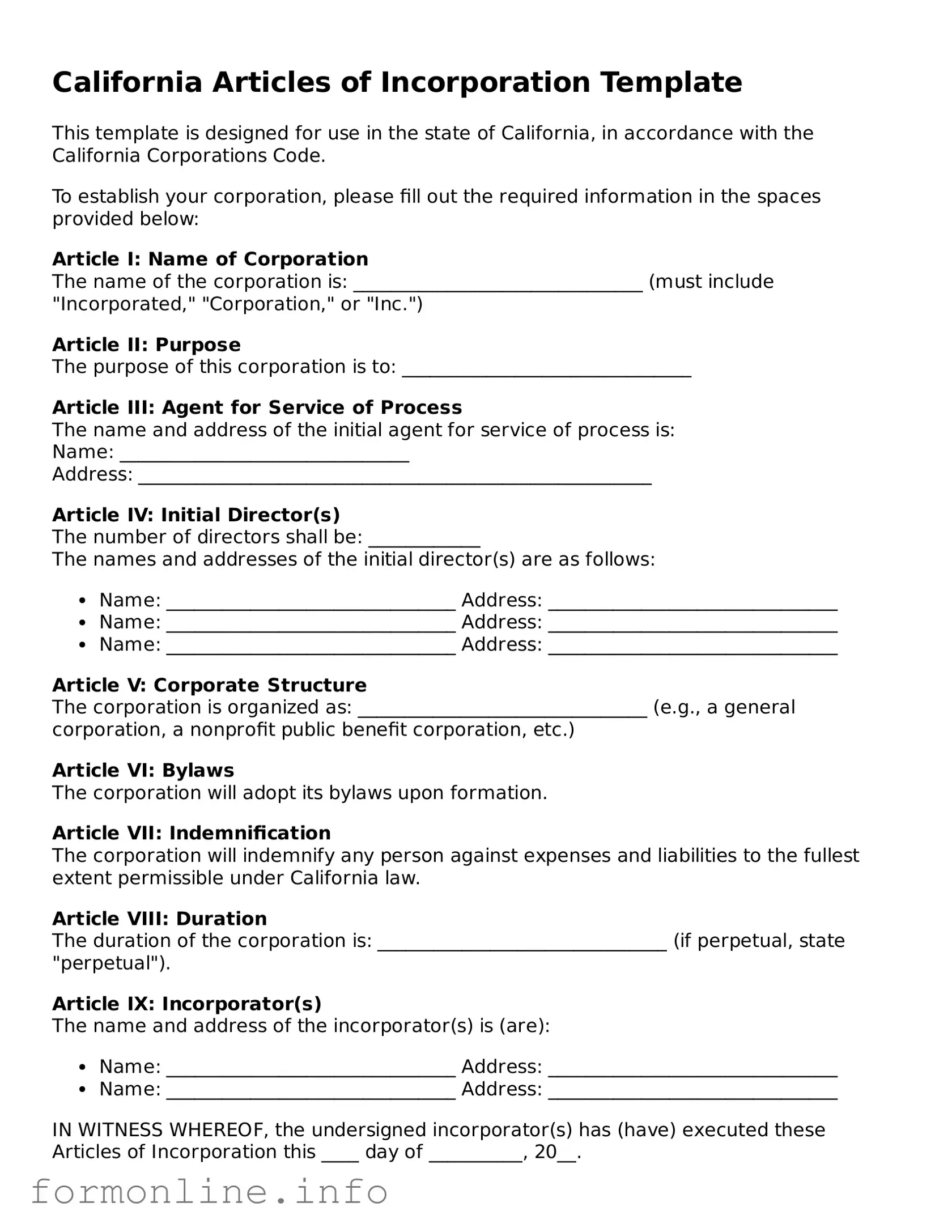The California Articles of Incorporation form is similar to the Certificate of Incorporation used in many states across the U.S. Both documents serve the primary purpose of officially establishing a corporation. They require basic information such as the corporation's name, purpose, and registered agent. While the specific requirements may vary from state to state, the fundamental goal remains the same: to create a legal entity that can conduct business, enter contracts, and protect its owners from personal liability.
Another comparable document is the Bylaws of a corporation. Bylaws outline the internal rules and procedures for managing the corporation. While the Articles of Incorporation focus on external establishment, Bylaws delve into the governance structure, including the roles of directors and officers, meeting protocols, and voting procedures. Both documents are essential for the functioning of a corporation, but they serve different purposes in defining its operation and organization.
The Limited Liability Company (LLC) Articles of Organization serves a similar function for LLCs. Like the Articles of Incorporation, this document is filed with the state to formally create a legal entity. It includes basic information about the LLC, such as its name, address, and management structure. Both documents provide liability protection to their owners, but the LLC Articles of Organization cater specifically to the unique structure and flexibility of limited liability companies.
The Partnership Agreement is another document that shares similarities with the Articles of Incorporation. While the Articles establish a corporation, the Partnership Agreement formalizes the relationship between partners in a business. It outlines each partner's contributions, responsibilities, profit-sharing arrangements, and dispute resolution methods. Both documents are crucial for clarifying roles and expectations, but they apply to different business structures.
The Certificate of Formation is often used interchangeably with the Articles of Incorporation in some states. This document serves to create a corporation and includes similar information, such as the name of the corporation, its purpose, and the registered agent. The primary distinction lies in the terminology used, which can vary by state, but the function remains consistent in establishing a legal entity.
The Statement of Information is another document that complements the Articles of Incorporation. While the Articles serve to create the corporation, the Statement of Information provides ongoing updates about the corporation’s status, including changes in address, officers, and business activities. This document ensures that the state has current information about the corporation, thereby promoting transparency and compliance.
Understanding the importance of each form related to business formation is critical for entrepreneurs. Among these, the Employment Verification form stands out as it confirms a candidate's job history and qualifications, facilitating a smooth hiring process. For comprehensive resources on employment-related documentation, visit Top Forms Online, which provides valuable insights and templates to assist both employers and job seekers in navigating these essential forms.
The Nonprofit Articles of Incorporation is tailored for organizations that operate without profit motives. Similar to the for-profit Articles of Incorporation, this document establishes the nonprofit entity, detailing its purpose and governance structure. Both documents require foundational information, but the nonprofit version includes specific language related to charitable purposes and the distribution of assets upon dissolution.
The Corporate Resolution is akin to the Articles of Incorporation in that it formalizes decisions made by the corporation's board of directors. While the Articles establish the corporation, a Corporate Resolution documents specific actions, such as the approval of contracts or the appointment of officers. Both are critical for corporate governance, but they address different aspects of corporate operations.
The Assumed Name Certificate, often referred to as a "Doing Business As" (DBA) registration, is similar in that it allows a corporation to operate under a name different from its legal name. While the Articles of Incorporation establish the legal entity, the Assumed Name Certificate provides the flexibility for branding and marketing. Both documents must be filed with the appropriate state authorities to ensure legal compliance.
Finally, the Federal Employer Identification Number (EIN) application is related to the Articles of Incorporation in that it is necessary for the corporation to operate legally. The EIN serves as a unique identifier for tax purposes. While the Articles create the corporation, the EIN is essential for opening bank accounts, hiring employees, and filing taxes. Both documents are fundamental for the legal and operational aspects of a corporation.
